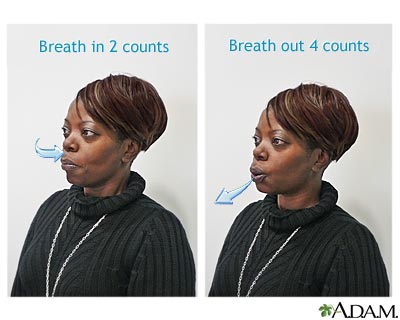How to breathe when you are short of breath
Pursed lip breathing; COPD - pursed lip breathing; Emphysema - pursed lip breathing; Chronic bronchitis - pursed lip breathing; Pulmonary fibrosis - pursed lip breathing; Interstitial lung disease - pursed lip breathing; Hypoxia - pursed lip breathing; Chronic respiratory failure - pursed lip breathing
Images

I Would Like to Learn About:
When to use Pursed lip Breathing
Pursed lip breathing helps you use less energy to breathe. It can help you relax. When you are short of breath, it helps you slow the pace of your breathing and can help you feel less short of breath.
Use pursed lip breathing when you do things that make you short of breath, such as when you:
- Exercise
- Bend
- Lift
- Climb stairs
- Feel anxious
You can practice pursed lip breathing anytime. Try to practice 4 or 5 times a day when you:
- Watch TV
- Use your computer
- Read a newspaper
How to do Pursed lip Breathing
The steps to do pursed lip breathing are:
- Relax the muscles in your neck and shoulders.
- Sit in a comfortable chair with your feet on the floor.
- Inhale slowly through your nose for 2 counts.
- Feel your belly get larger as you breathe in.
- Pucker your lips, as if you were going to whistle or blow out a candle.
- Exhale slowly through your lips for 4 or more counts.
Exhale normally. Do not force the air out. Do not hold your breath when you are doing pursed lip breathing. Repeat these steps until your breathing slows.
Related Information
Lung surgeryChronic obstructive pulmonary disease (COPD)
Cystic fibrosis
Interstitial lung disease
Community-acquired pneumonia in adults
Bronchiolitis
Breathing difficulty
Chronic obstructive pulmonary disease - adults - discharge
Interstitial lung disease - adults - discharge
COPD - control drugs
COPD - quick-relief drugs
Lung surgery - discharge
References
Minichiello VJ. Therapeutic breathing. In: Rakel D, Minichiello VJ, eds. Integrative Medicine. 5th ed. Philadelphia, PA: Elsevier; 2023:chap 89.
Rochester CL, Nici L. Pulmonary rehabilitation. In: Broaddus VC, Ernst JD, King TE, Lazarus SC, Sarmiento KF, Schnapp LM, Stapleton RD, eds. Murray and Nadel's Textbook of Respiratory Medicine. 7th ed. Philadelphia, PA: Elsevier; 2022:chap 139.
Schwartzstein RM, Adams L. Dyspnea. In: Broaddus VC, Ernst JD, King TE, Lazarus SC, Sarmiento KF, Schnapp LM, Stapleton RD, eds. Murray and Nadel's Textbook of Respiratory Medicine. 7th ed. Philadelphia, PA: Elsevier; 2022:chap 36.
BACK TO TOPReview Date: 2/3/2024
Reviewed By: Frank D. Brodkey, MD, FCCM, Associate Professor, Section of Pulmonary and Critical Care Medicine, University of Wisconsin School of Medicine and Public Health, Madison, WI. Also reviewed by David C. Dugdale, MD, Medical Director, Brenda Conaway, Editorial Director, and the A.D.A.M. Editorial team.

Health Content Provider
06/01/2025
|
A.D.A.M., Inc. is accredited by URAC, for Health Content Provider (www.urac.org). URAC's accreditation program is an independent audit to verify that A.D.A.M. follows rigorous standards of quality and accountability. A.D.A.M. is among the first to achieve this important distinction for online health information and services. Learn more about A.D.A.M.'s editorial policy, editorial process and privacy policy. A.D.A.M. is also a founding member of Hi-Ethics. This site complied with the HONcode standard for trustworthy health information from 1995 to 2022, after which HON (Health On the Net, a not-for-profit organization that promoted transparent and reliable health information online) was discontinued. |
The information provided herein should not be used during any medical emergency or for the diagnosis or treatment of any medical condition. A licensed medical professional should be consulted for diagnosis and treatment of any and all medical conditions. Links to other sites are provided for information only -- they do not constitute endorsements of those other sites. © 1997- 2025 A.D.A.M., a business unit of Ebix, Inc. Any duplication or distribution of the information contained herein is strictly prohibited.
